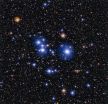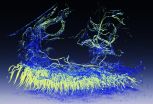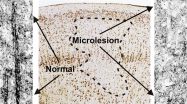(Press-News.org) Messier 47 is located approximately 1600 light-years from Earth, in the constellation of Puppis (the poop deck of the mythological ship Argo). It was first noticed some time before 1654 by Italian astronomer Giovanni Battista Hodierna and was later independently discovered by Charles Messier himself, who apparently had no knowledge of Hodierna's earlier observation.
Although it is bright and easy to see, Messier 47 is one of the least densely populated open clusters. Only around 50 stars are visible in a region about 12 light-years across, compared to other similar objects which can contain thousands of stars.
Messier 47 has not always been so easy to identify. In fact, for years it was considered missing, as Messier had recorded the coordinates incorrectly. The cluster was later rediscovered and given another catalogue designation -- NGC 2422. The nature of Messier's mistake, and the firm conclusion that Messier 47 and NGC 2422 are indeed the same object, was only established in 1959 by Canadian astronomer T. F. Morris.
The bright blue-white colours of these stars are an indication of their temperature, with hotter stars appearing bluer and cooler stars appearing redder. This relationship between colour, brightness and temperature can be visualised by use of the Planck curve. But the more detailed study of the colours of stars using spectroscopy also tells astronomers a lot more -- including how fast the stars are spinning and their chemical compositions. There are also a few bright red stars in the picture -- these are red giant stars that are further through their short life cycles than the less massive and longer-lived blue stars [1].
By chance Messier 47 appears close in the sky to another contrasting star cluster -- Messier 46. Messier 47 is relatively close, at around 1600 light-years, but Messier 46 is located around 5500 light-years away and contains a lot more stars, with at least 500 stars present. Despite containing more stars, it appears significantly fainter due to its greater distance.
Messier 46 could be considered to be the older sister of Messier 47, with the former being approximately 300 million years old compared to the latter's 78 million years. Consequently, many of the most massive and brilliant of the stars in Messier 46 have already run through their short lives and are no longer visible, so most stars within this older cluster appear redder and cooler.
This image of Messier 47 was produced as part of the ESO Cosmic Gems programme [2].
INFORMATION:
Notes
[1] The lifetime of a star depends primarily on its mass. Massive stars, containing many times as much material as the Sun, have short lives measured in millions of years. On the other hand much less massive stars can continue to shine for many billions of years. In a cluster, the stars all have about the same age and same initial chemical composition. So the brilliant massive stars evolve quickest, become red giants sooner, and end their lives first, leaving the less massive and cooler ones to long outlive them.
[2] The ESO Cosmic Gems programme is an outreach initiative to produce images of interesting, intriguing or visually attractive objects using ESO telescopes, for the purposes of education and public outreach. The programme makes use of telescope time that cannot be used for science observations. All data collected may also be suitable for scientific purposes, and are made available to astronomers through ESO's science archive.
More information
ESO is the foremost intergovernmental astronomy organisation in Europe and the world's most productive ground-based astronomical observatory by far. It is supported by 15 countries: Austria, Belgium, Brazil, the Czech Republic, Denmark, France, Finland, Germany, Italy, the Netherlands, Portugal, Spain, Sweden, Switzerland and the United Kingdom. ESO carries out an ambitious programme focused on the design, construction and operation of powerful ground-based observing facilities enabling astronomers to make important scientific discoveries. ESO also plays a leading role in promoting and organising cooperation in astronomical research. ESO operates three unique world-class observing sites in Chile: La Silla, Paranal and Chajnantor. At Paranal, ESO operates the Very Large Telescope, the world's most advanced visible-light astronomical observatory and two survey telescopes. VISTA works in the infrared and is the world's largest survey telescope and the VLT Survey Telescope is the largest telescope designed to exclusively survey the skies in visible light. ESO is the European partner of a revolutionary astronomical telescope ALMA, the largest astronomical project in existence. ESO is currently planning the 39-metre European Extremely Large optical/near-infrared Telescope, the E-ELT, which will become "the world's biggest eye on the sky".
Links
* Photos of the MPG/ESO 2.2-metre telescope: http://www.eso.org/public/images/archive/search/?adv=&subject_name=mpg
* Other photos taken with the MPG/ESO 2.2-metre telescope: http://www.eso.org/public/images/archive/search/?adv=&facility=15
* Photos of La Silla: http://www.eso.org/public/images/archive/category/lasilla/
Contacts
Richard Hook
ESO Public Information Officer
Garching bei München, Germany
Tel: +49 89 3200 6655
Email: rhook@eso.org
Treating bacterial infections with antibiotics is becoming increasingly difficult as bacteria develop resistance not only to the antibiotics being used against them, but also to ones they have never encountered before. By analyzing genetic and phenotypic changes in antibiotic-resistant strains of E. coli, researchers at the RIKEN Quantitative Biology Center (QBiC) in Japan have revealed a common set of features that appear to be responsible for the development of resistance to several types of antibiotics.
The study published in Nature Communications shows that resistance ...
Fireflies used rapid light flashes to communicate. This "bioluminescence" is an intriguing phenomenon that has many potential applications, from drug testing and monitoring water contamination, and even lighting up streets using glow-in-dark trees and plants. Fireflies emit light when a compound called luciferin breaks down. We know that this reaction needs oxygen, but what we don't know is how fireflies actually supply oxygen to their light-emitting cells. Using state-of-the-art imaging techniques, scientists from Switzerland and Taiwan have determined how fireflies control ...
This news release is available in French. This news release is available in French.
People with a severe mental disorder who commit a crime and who are incarcerated have different characteristics compared to people who are hospitalized after committing an offence. These are the findings of a study by researchers at the Institut universitaire en santé mentale de Montréal (IUSMM) and the Institut Philippe-Pinel de Montréal (IPPM), affiliated with the University of Montreal.
"We found a clear difference between people with a mental illness who are ...
Cancer Research UK scientists have shown that loss of a gene called PTEN triggers some cases of an aggressive form of ovarian cancer, called high-grade serous ovarian cancer, according to a study published in Genome Biology today (Wednesday)*.
In a revolutionary approach the researchers from the Cancer Research UK Cambridge Institute made the discovery by combining images from cancer samples with genetic data. They proved conclusively that loss of PTEN was commonly found only in the cancerous cells and not the 'normal' cells that help make up the tumour mass.
PTEN ...
Using an innovative technique combining genetic analysis and mathematical modeling with some basic sleuthing, researchers have identified previously undescribed microlesions in brain tissue from epileptic patients. The millimeter-sized abnormalities may explain why areas of the brain that appear normal can produce severe seizures in many children and adults with epilepsy.
The findings, by researchers at the University of Illinois at Chicago College of Medicine, Wayne State University and Montana State University, are reported in the journal Brain.
Epilepsy affects about ...
The deep sea is becoming a collecting ground for plastic waste, according to research led by scientists from Plymouth University and Natural History Museum.
The new study, published today in Royal Society Open Science, reveals around four billion microscopic plastic fibres could be littering each square kilometre of deep sea sediment around the world.
Marine plastic debris is a global problem, affecting wildlife, tourism and shipping. Yet monitoring over the past decades has not seen its concentration increase at the sea surface or along shorelines, despite experts ...
New research suggests our jawed ancestors weren't responsible for the demise of their jawless cousins as had been assumed. Instead Dr Robert Sansom from The University of Manchester believes rising sea levels are more likely to blame. His research has been published in the journal Proceedings of the Royal Society B.
He says: "When our jawed vertebrate ancestors overtook their jawless relatives 400 million years ago, it seems that it might not have been through direct competition but instead the inability of our jawless cousins to adapt to changing environmental conditions."
In ...
In another demonstration that brain-computer interface technology has the potential to improve the function and quality of life of those unable to use their own arms, a woman with quadriplegia shaped the almost human hand of a robot arm with just her thoughts to pick up big and small boxes, a ball, an oddly shaped rock, and fat and skinny tubes.
The findings by researchers at the University of Pittsburgh School of Medicine, published online today in the Journal of Neural Engineering, describe, for the first time, 10-degree brain control of a prosthetic device in which ...
NEW YORK (16 December 2014) -- The Population Council published new research in the November issue of the journal Contraception demonstrating that an investigational one-year contraceptive vaginal ring containing Nestorone® and ethinyl estradiol was found to be highly acceptable among women enrolled in a Phase 3 clinical trial. Because the perspectives of women are critical for defining acceptability, researchers developed a theoretical model based on women's actual experiences with this contraceptive vaginal ring, and assessed their overall satisfaction and adherence ...
American states got tough on impaired driving in the 1980s and 1990s, but restrictions have flat lined.
A new study looks at associations between levels and types of law-enforcement efforts and prevalence of drinking and driving.
The number of traffic stops and DUI arrests per capita had the most consistent and significant associations.
From 1982 to 1997, American states got tough on impaired driving. Policies favored adopting lower blood alcohol concentration (BAC) limits for driving, administrative license revocation (ALR), and increased sanctions for those convicted ...




